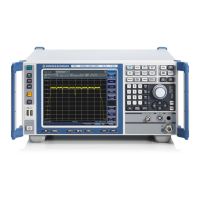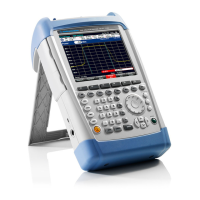Quick Start
R&S
®
FSVA/FSV
27Operating Manual 1176.7510.02 ─ 09
► Connect the R&S FSVA/FSV to the AC power supply using the supplied power
cable.
Since the instrument is assembled in line with the specifications for safety class
EN61010, it may only be connected to an outlet that has a ground contact.
2.2.1.5 Changing the AC Supply Fuse
Only fuses of the type IEC 60 127-T3.15H/250 V should be used. Those fuses are
used for all of the specified nominal AC supply voltages.
To change the AC supply fuses
1. Disconnect the power cable.
2. Open the flap covering the fuse holder using a small screwdriver (or similar).
3. Remove the fuse holder.
4. Remove both fuses and install the new ones.
5. Reinsert the fuse holder.
6. Close the flap.
2.2.1.6 Using an Optional DC Power Supply
When only DC power is available, for example from a battery or in a vehicle, an
optional DC power supply adapter (R&S FSV-B30) can be connected to the
R&S FSVA/FSV to operate the instrument with a DC voltage of 10 V to 15 V. Two dif-
ferent types of battery packs are available as separate options for the R&S FSVA/FSV.
Depending on which battery pack option is used, different cables are provided to con-
nect it to the DC power supply adapter.
For installation instructions see the option's installation guide.
Shock hazard due to power supply
The used power supply (SELV) must fulfill the requirements for reinforced/double insu-
lation for main supply circuits in accordance with DIN/EN/IEC 61010 (UL 3111, CSA
C22.2 No. 1010.1) or DIN/EN/IEC 60950 (UL 1950, CSA C22.2 No. 950) . Current limi-
tation must be provided in accordance with DIN EN 61010‑1 Appendix F2.1.
Before switching on the instrument check the connection for correct polarity to avoid
the risk of electric shock.
Before switching on the R&S FSVA/FSV, switch on the DC power supply:
Preparing for Use

